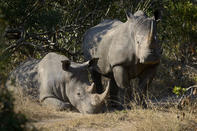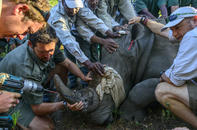A Misguided Market
By far the most tragic issue facing the Kruger (and many other conservation areas across Africa) is the dramatic increase in rhino poaching over the last few years.

The main reason for this slaughter is mind-blowingly idiotic – men can’t seem to get it up without some ground-up rhino horn in their food! This benighted traditional remedy combined with a rising wave of prosperity sweeping across the region has pushed the demand for rhino horn through the roof. Already, the Western Black Rhino was declared extinct by the International Union for Conservation of Nature (IUCN) in 2011. The other five remaining rhino species are all listed in the IUCN Red List of threatened species.
A Passionate Reaction

In South Africa alone, the number of rhinos killed for their horns has skyrocketed to the point that, unless the trend is reversed, rhino deaths will outstrip births within the next couple of years. This is a huge issue because South Africa is home to over 80% of Africa’s rhinos and 73% of the world’s wild rhino population.
Unsurprisingly, it’s an issue that has provoked a passionate reaction in the general public who have rallied around their precious rhinos with increasing fervour. But it is a scourge that is proving hard to stop. With rising prices and a growing demand for the product, several international syndicates have established sophisticated poaching networks complete with helicopters, tranquiliser guns and smuggling routes.
To counter the poachers (many of whom are impoverished locals being exploited by their wealthy overlords), a number of anti-poaching initiatives have been launched. A variety of rhino conservation organisations have been established. Large donations have poured in from all over the world. Patrols in reserves have been stepped up. Arrests have been made (including several prominent vets and rangers). Anti-poaching legislation has been improved, with more severe penalties.
The Massacre Continues

Other increasingly desperate remedies to the problem are being floated every day: poisoning rhino horns, injecting horns with dye, cutting off horns as a preventative measure, and legalising the trade in horn have all been discussed, but the daily press is still filled with terrible photos of butchered rhinos and the massacre continues unabated.
On a more positive note, in January 2017, SANParks launched their innovative ‘Meerkat’ wide-range surveillance units. Developed by SA’s Council for Scientific and Industrial Research (CSIR) and supported by the Peace Parks Foundation with contributions from UK lottery funds, Meerkat uses radar to detect and map suspicious movements in the reserve. This compact system can fold up and fit in the back of a truck, with only a small team required for operations.
Equally effective during the day and at night, the first Meerkat unit managed to stop five out of nine detected poaching incidents over the course of two weeks. Following this successful pilot project, it is hoped that an additional three or four units will be able to cover the entire park and finally bring the poachers to heel. One can only hope that the cumulative effects of the anti-poaching lobby will eventually begin to take hold and the number of dead rhinos will start to fall. Until then, we can only contribute to the fight in any way we can.
By David Fleminger Armoured with strong hides and a menacing horn, the African rhinoceros can graze undeterred alongside resting lions in the bushveld of South...
Armoured with strong hides and a menacing horn, the African rhinoceros can graze undeterred alongside resting lions in the bushveld of South...